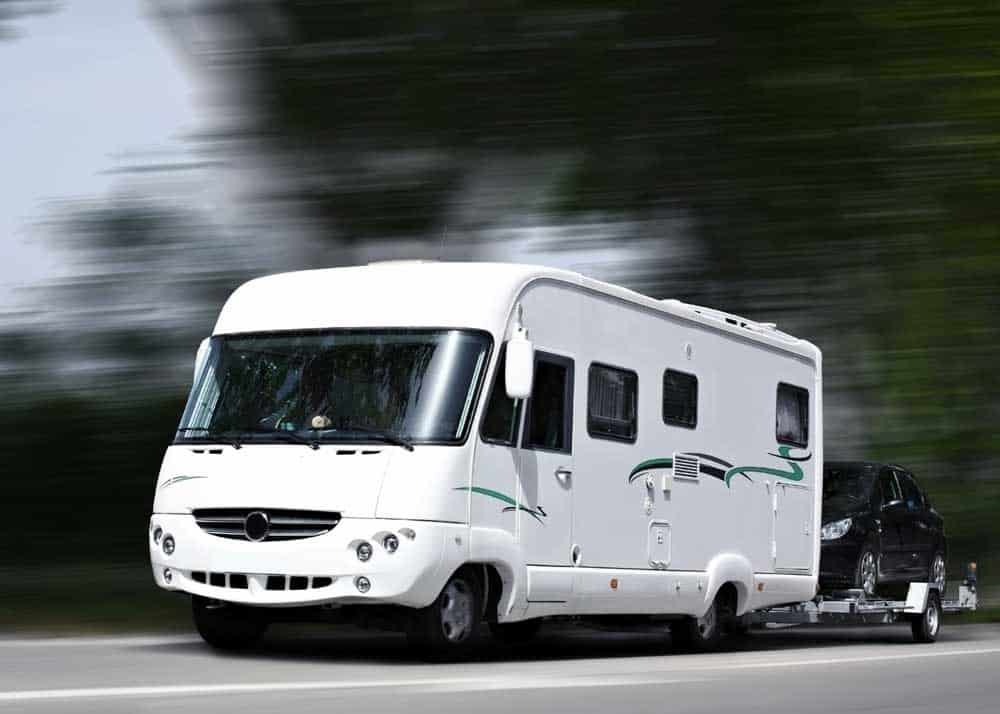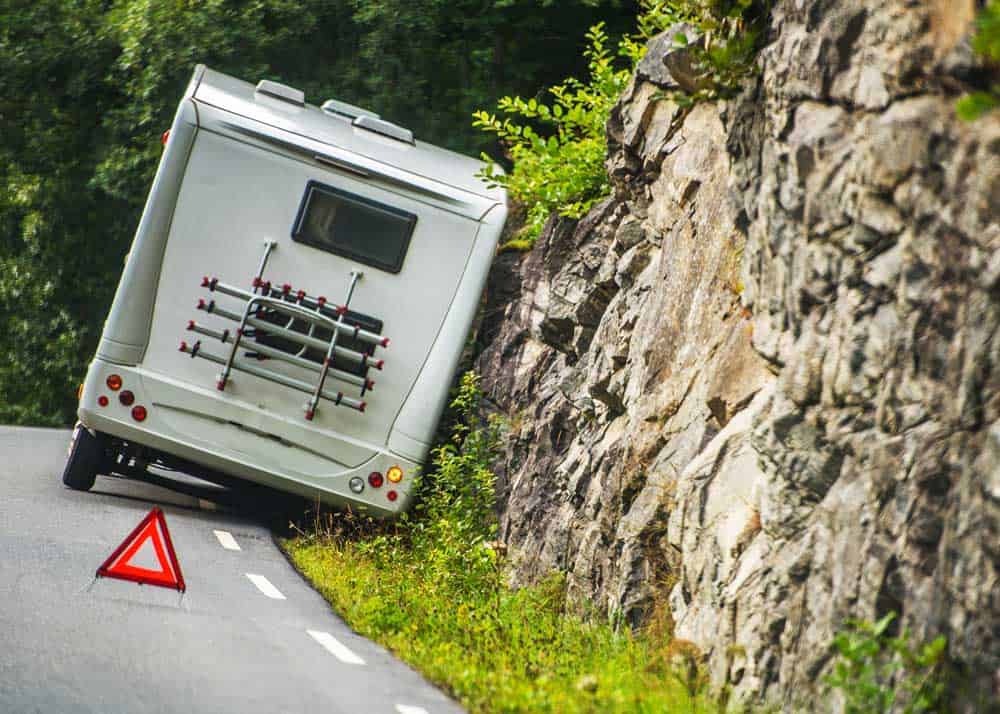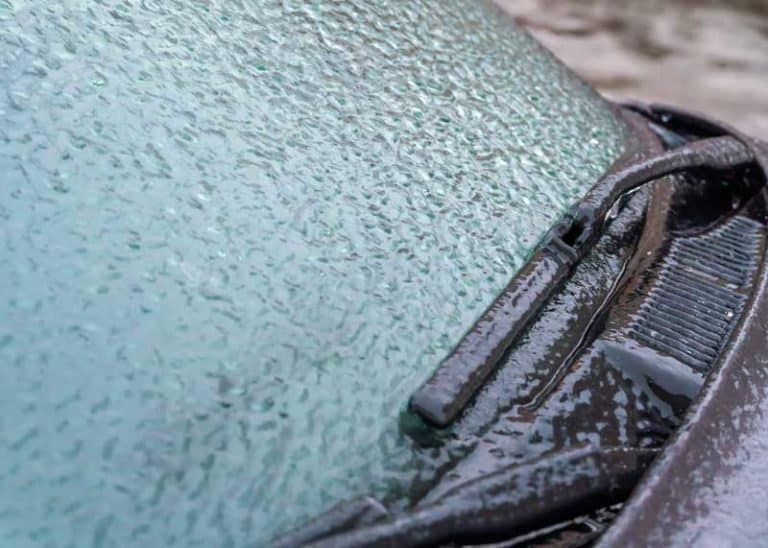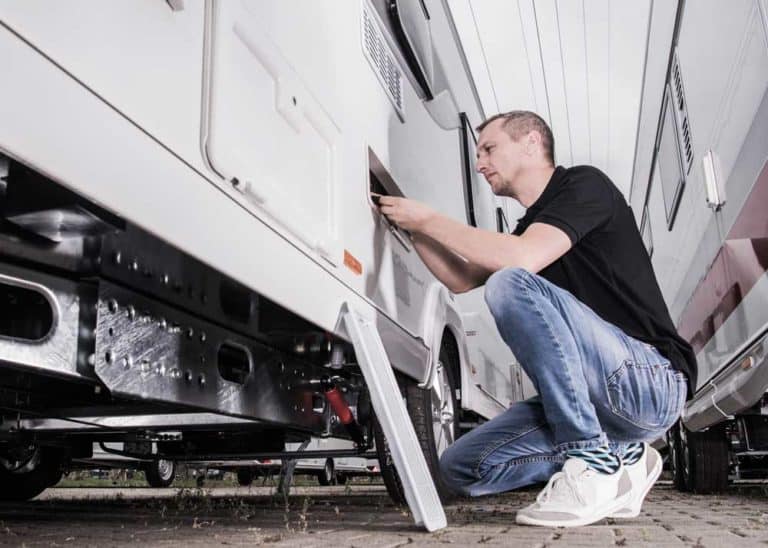How Much Wind Can an RV Withstand? Moving / Parked (2 Charts)
High winds in an RV can be dangerous. Just how much wind can an RV withstand? In this post, we’ll cover all the details (two charts) for a safe RV adventure. But first, here is the
Winds as low as 10 miles per hour can affect a moving RV, making it hazardous to drive. When parked, most RVs can withstand winds up to 75 mph (120 km/h) without tipping over.
The amount of wind that an RV can withstand will depend largely on the type of RV and whether it is moving or stationary.

If you are one of the millions of Americans that take to the road in an RV each year, at some point during your travels, you may have experienced driving or camping in high winds.
Whether it’s traveling through a mountain pass or parking at a campsite, gusty winds are a force that every RV owner must be prepared to deal with, for their well-being and the safety of others.
RVs are high-profile vehicles, which means they are affected by the movement of air around them.
Being knowledgeable about how to drive in windy conditions, and what to do if winds are gusting and your RV is parked, is part of being a responsible RV owner.
Fortunately, there are steps you can take that can help see you and your RV through dangerous wind conditions with minimal damage.
Is There a Limit to How Much Wind an RV Can Withstand?
Aside from being struck by flying or falling debris, the main concern with RVs concerning high winds is the danger of tipping over.
Whether an RV is being driven or it is parked, a powerful gust of wind can potentially exert enough force on the vehicle’s broadside to knock it off its center of gravity, and in extreme cases, move it past its tipping point and onto its side.
Driving an RV in Windy Conditions
While one of the reasons that RVs are so popular is that practically anyone with a driver’s license can drive one, the fact remains that they require a higher level of care when being operated than regular vehicles like the one you drive to work.
This is particularly true when driving an RV in adverse weather conditions, such as when winds are blowing hard.
RVs come in different lengths, widths, shapes, and weights, and these measurements are critical when determining the amount of wind force a particular recreational vehicle can withstand.
Generally speaking, due to how aerodynamic forces work, RVs are far more susceptible to tipping over because of high winds when they are moving, versus when they are stationary.
Here’s a look at how much even nominal wind speed can affect an RV on the road, particularly if the winds are hitting the broad side of the vehicle:
| Wind Speed (MPH) | Wind Speed (KPH) | Effect on Moving RV |
|---|---|---|
| 10 MPH | 16 KPH | Driving at highway speeds can be noticeably affected |
| 20 MPH | 32 KPH | Driving at highway speeds can be dramatically impaired |
| 30 MPH | 48 KPH | Driving at highway speeds is hazardous (especially with embedded gusts) |
Source: Good Sam

The moral of the story as far as driving an RV in windy conditions is to slow down if your ability to drive at highway speeds is noticeably affected.
Knowing your travel route, including passes and mountainous areas where wind gusts are common, can be valuable when planning your trip and being prepared for challenging driving conditions.
Driving with the wind is far easier and safer than driving into crosswinds, as these can hit your broadside with full wind force.
Driving Travel Trailers and Fifth Wheel Trailers in High Winds
When it comes to driving an RV in windy conditions, great care must be exercised regardless of the size or type of recreational vehicle.
In the case of travel trailers and fifth-wheel trailers, however, the level of care rises to extreme caution.
The road dynamics of a tow vehicle and its trailer differ greatly from that of a motor home, particularly when windy conditions are involved.
Even in ideal driving conditions, drivers of vehicles towing travel or fifth-wheel trailers must be ever vigilant against dreaded trailer sway.
Trailer sway occurs when the trailer begins to move uncontrollably from side to side behind the tow vehicle (this is also known as fish-tailing or jack-knifing). One of the biggest contributing factors to trailer sway is any force pushing on the trailer’s broadside, and the most common of these is wind. Source Hensley Mfg.
Because the side of a trailer has a much larger surface area (length times height) than the vehicle towing it, a crosswind will exert more force on the former than the latter.
Generally speaking, the larger the trailer, the more force will push against the side of it, and the more susceptible it will be to sway. It is this imbalance in force that makes towing an RV trailer in windy conditions challenging at best and treacherous at worst. Source Outdoorsy
Even wind gusts of 20 to 30 miles per hour can give the most seasoned of RV-ers pause to re-consider or re-route travel plans, or pull over and wait until winds subside to safer levels. Source Jayco Owners Forum
Parking an RV in Windy Conditions
RVs are far more capable of withstanding high winds when they are parked and stationary than when they are moving.
Whereas wind speeds as low as 10 to 20 miles per hour can affect RV driving safety, one study has shown that it would take a minimum gust of 53 miles per hour, hitting the side of an unhitched travel trailer (measuring 18 feet in length) perfectly straight-on, to tip it over.
Another study, focused specifically on tornadoes and the effects of their wind forces on vehicles, found higher wind thresholds (measured one meter above the ground) were needed to overturn vehicles:
Fujita Scale: Tornado Wind Speeds for Overturning Stationary Vehicles
| Fujita Wind Scale | Wind Speed | Effect on Vehicles |
|---|---|---|
| F0 | 75 MPH | No vehicles expected to be overturned by winds |
| F1 | 95 MPH | Semi-trucks and high-profile trailers and buses may be tipped over |
| F2 | 125 MPH | Cars, vans, and pickups may be moved, but more than 10% will be tipped over |
| F3 | 155 MPH | 10% to 50% of cars, vans, and pickups are tipped over and may be rolled or thrown |
Source: American Meteorological Society Link opens PDF “Wind Speeds Required to Upset Vehicles” Study
Although their wind thresholds differ quite significantly, both studies conclude that a lot of wind speed is required to overturn an RV that is parked or stationary.
Of course, individual cases will differ, and there are many variables to consider, such as:
- The shape and dimensions of a particular RV
- If the RV is a travel trailer or fifth-wheel trailer, whether it is hitched to a tow vehicle
- Whether the RV is square-ish in shape or has a more aerodynamic profile, particularly its broadside (i.e., a boxy RV like an older model Winnebago or a streamlined RV like an Airstream)
- Whether it is empty or fully laden with furniture, gear, food, water, etc.
Hitting the road? Here’s how to keep your RV fridge cold while driving.
How to Stabilize an RV Against High Winds
It takes powerful, sustained wind gusts to tip over a parked RV, so the chances that your RV will be overturned in windy conditions are pretty slim.
But by no means should you ignore common sense when you know that high winds are in the weather forecast.
Even if your RV remains upright in 50+ mile per hour winds, it can still sustain significant structural damage if certain precautions are not taken.
One of the first things you should do when parking your RV in windy conditions is to deploy your stabilizers, as they provide additional points of contact between your RV and the ground.
Many stabilizers are built into RV underbodies, or they can be purchased as aftermarket accessories.
By leveling your RV and distributing the weight evenly, stabilizers ensure that your RV will be steady as it can be once wind gusts start blowing. Source Tripsavvy
Here are some additional tips for steadying your parked RV in windy conditions:
- Position your RV so that the wind gusts are not striking its broadside straight on; in other words, the ideal position of your RV is pointing straight into the wind. This applies whether your RV is a motorhome, travel trailer, or fifth-wheel trailer.
- If your RV is a travel trailer or fifth-wheel trailer, it may be advisable to hitch the RV to your tow vehicle (with both pointing into the direction of the wind) to anchor your RV and to allow the combined weight to work for you. (There is also another school of thought that calls for positioning the tow vehicle between the wind and the RV to act as a buffer.)
- Retract all awnings and slide-outs to minimize the outer profile and footprint of the RV as much as possible.
- Close all vents and windows to encourage airflow to wrap around your RV.
Source Eat See RV
For RV owners who live in areas prone to hurricanes, there are hurricane straps that can anchor your RV to the ground via concrete footings, trees, or other immovable objects.
Some RV owners fill their freshwater tanks to the brim, thereby adding up to 800 pounds of additional weight to weigh the RV down to the ground. Source Forest River Forums
A Final Word of Caution when Parking an RV in Windy Conditions
Even if your RV is properly stabilized to withstand hurricane-force winds, it remains a large target for flying or falling debris.
Stay away from glass windows if you are inside an RV during extremely windy conditions, as objects can come crashing in through them.
And if at all possible, avoid parking underneath with large limbs, as falling branches can be just as destructive as the RV tipping over.
Trouble within interior condensation? Here’s how to defog your windshield in the summer.

More reading: How much does it cost to install RV hookups?
Safe RV Travels
According to industry statistics, roughly 25 million Americans take to the road in an RV each year. Source: RV Industry Association
While it is highly unlikely that an RV will tip over while parked, even in the middle of a severe windstorm, driving an RV in windy conditions is another matter.
Considering that it is not only your safety but also that of those who share the road with you, erring on the side of caution seems like the right move.






